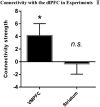Transforming brain signals related to value evaluation and self-control into behavioral choices
- PMID: 30593684
- PMCID: PMC6865472
- DOI: 10.1002/hbm.24379
Transforming brain signals related to value evaluation and self-control into behavioral choices
Erratum in
-
Corrigendum to Zha (2019), Transforming brain signals related to value evaluation and self-control into behavioural choices.Hum Brain Mapp. 2020 Oct 1;41(14):4148-4149. doi: 10.1002/hbm.25113. Epub 2020 Jul 16. Hum Brain Mapp. 2020. PMID: 33448516 Free PMC article. No abstract available.
Abstract
The processes involved in value evaluation and self-control are critical when making behavioral choices. However, the evidence linking these two types of processes to behavioral choices in intertemporal decision-making remains elusive. As the ventromedial prefrontal cortex (vmPFC), striatum, and dorsolateral prefrontal cortex (dlPFC) have been associated with these two processes, we focused on these three regions. We employed functional magnetic resonance imaging during a delayed discounting task (DDT) using a relatively large sample size, three independent samples. We evaluated how much information about a specific choice could be decoded from local patterns in each brain area using multivoxel pattern analysis (MVPA). To investigate the relationship between the dlPFC and vmPFC/striatum regions, we performed a psychophysiological interaction (PPI) analysis. In Experiment I, we found that the vmPFC and dlPFC, but not the striatum, could determine choices in healthy participants. Furthermore, we found that the dlPFC showed significant functional connectivity with the vmPFC, but not the striatum, when making decisions. These results could be replicated in Experiment II with an independent sample of healthy participants. In Experiment III, the choice-decoding accuracy in the vmPFC and dlPFC was lower in patients with addiction (smokers and participants with Internet gaming disorder) than in healthy participants, and decoding accuracy in the dlPFC was related to impulsivity in addicts. Taken together, our findings may provide neural evidence supporting the hypothesis that value evaluation and self-control processes both guide the intertemporal choices, and might provide potential neural targets for the diagnosis and treatment of impulsivity-related brain disorders.
Keywords: functional magnetic resonance imaging; intertemporal decision-making; multivoxel pattern analysis; self-control; valuation.
© 2018 Wiley Periodicals, Inc.
Conflict of interest statement
The authors declare no potential conflict of interests.
Figures








Similar articles
-
Interactions between dorsolateral and ventromedial prefrontal cortex underlie context-dependent stimulus valuation in goal-directed choice.J Neurosci. 2014 Nov 26;34(48):15988-96. doi: 10.1523/JNEUROSCI.3192-14.2014. J Neurosci. 2014. PMID: 25429140 Free PMC article. Clinical Trial.
-
The preference for future outcomes correlates with the temporal variability of functional connectivity among brain regions.Behav Brain Res. 2019 Dec 16;375:112111. doi: 10.1016/j.bbr.2019.112111. Epub 2019 Aug 9. Behav Brain Res. 2019. PMID: 31404558
-
Neuroanatomy of the vmPFC and dlPFC Predicts Individual Differences in Cognitive Regulation During Dietary Self-Control Across Regulation Strategies.J Neurosci. 2018 Jun 20;38(25):5799-5806. doi: 10.1523/JNEUROSCI.3402-17.2018. Epub 2018 Jun 4. J Neurosci. 2018. PMID: 29866743 Free PMC article.
-
[Decision-making and schizophrenia].Encephale. 2011 Dec;37 Suppl 2:S110-6. doi: 10.1016/S0013-7006(11)70036-7. Encephale. 2011. PMID: 22212839 Review. French.
-
The neural basis of effort valuation: A meta-analysis of functional magnetic resonance imaging studies.Neurosci Biobehav Rev. 2021 Dec;131:1275-1287. doi: 10.1016/j.neubiorev.2021.10.024. Epub 2021 Oct 25. Neurosci Biobehav Rev. 2021. PMID: 34710515 Review.
Cited by
-
The functional connectivity between the dorsolateral prefrontal cortex and the medial prefrontal cortex underlying the association between self-control and delay discounting.Brain Struct Funct. 2025 May 21;230(5):71. doi: 10.1007/s00429-025-02936-2. Brain Struct Funct. 2025. PMID: 40397223
-
Decoding and modifying dynamic attentional bias in gaming disorder.Philos Trans R Soc Lond B Biol Sci. 2024 Dec 2;379(1915):20230090. doi: 10.1098/rstb.2023.0090. Epub 2024 Oct 21. Philos Trans R Soc Lond B Biol Sci. 2024. PMID: 39428882 Free PMC article.
-
Mapping expectancy-based appetitive placebo effects onto the brain in women.Nat Commun. 2024 Jan 4;15(1):248. doi: 10.1038/s41467-023-44569-1. Nat Commun. 2024. PMID: 38172100 Free PMC article.
-
Morphometric Evidence of a U-Shaped Relationship Between Loss Aversion and Posterior Insular/Somatosensory Cortical Features.Hum Brain Mapp. 2025 Jul;46(10):e70274. doi: 10.1002/hbm.70274. Hum Brain Mapp. 2025. PMID: 40580012 Free PMC article.
-
Psychometric properties of the Chinese version of the Quick Delay Questionnaire (C-QDQ) and ecological characteristics of reward-delay impulsivity of adults with ADHD.BMC Psychiatry. 2024 Apr 2;24(1):251. doi: 10.1186/s12888-024-05706-2. BMC Psychiatry. 2024. PMID: 38566048 Free PMC article.
References
-
- Al Omari, O. , Razeq, N. M. A. , & Fooladi, M. M. (2016). Experience of menarche among Jordanian adolescent girls: An interpretive phenomenological analysis. Journal of Pediatric and Adolescent Gynecology, 29, 246–251. - PubMed
Publication types
MeSH terms
Grants and funding
- 2016YFA0400900/The National Key Basic Research Program/International
- 2018YFC0831101/The National Key Basic Research Program/International
- 31471071/National Natural Science Foundation of China/International
- 31771221/National Natural Science Foundation of China/International
- 31800927/National Natural Science Foundation of China/International
LinkOut - more resources
Full Text Sources
Research Materials
Miscellaneous

